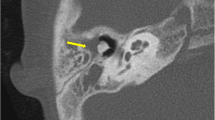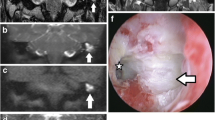Abstract
Acquired and congenital cholesteatoma result in aggressive bony erosion affecting middle/inner ear structures. While the diagnosis is made clinically at otoscopy, this chapter explores the role of imaging with CT and MRI is to confirm presence, extent, identify complications and plan surgery.
The role of CT of temporal bones as the initial imaging modality of choice is discussed, typically demonstrating non-dependent soft tissue with associated bony erosion. However, as CT does not differentiate cholesteatoma from fluid or inflammation, both staging and follow-up are augmented with non-echo planar (EP) diffusion-weighted (DW) MRI.
In post-surgical follow-up, imaging interpretation requires knowledge of surgical technique employed, so the implications for clinic-radiological evaluation of ‘wall-up’, ‘wall-down’ or ‘combined approach’ are outlined. As a canal ‘wall-up’ approach is associated with more challenging disease clearance, routine ‘second-look’ procedures were previously routine to assess for residual or recurrent disease. Increasingly, however, non-EP DW-MRI has been used in this context.
The strengths and limitations of non-EP DW-MRI are presented (including common causes of false-positive results), emphasizing that imaging should be interpreted in conjunction with detailed information from the surgical team and with reference to temporal bone anatomy on CT, for which image fusion can assist.
Access this chapter
Tax calculation will be finalised at checkout
Purchases are for personal use only
Similar content being viewed by others
References
Gray JD. The chronic ear. The treatment of cholesteatoma in children. Proc R Soc Med. 1964;57:769–71.
Wang RG, Hawke M, Kwok P. The epidermoid formation (Michaels’ structure) in the developing middle ear. J Otolaryngol. 1987;16(6):327–30.
Tierney PA, Pracy P, Blaney SP, et al. An assessment of the value of the preoperative computed tomography scans prior to otoendoscopic “second look” in intact canal wall mastoid surgery. Clin Otolaryngol Allied Sci. 1999;24:274e6.
Majithia A, Lingam RK, Nash R, Khemani S, Kalan A, Singh A. Staging primary middle ear cholesteatoma with non-echoplanar (half-Fourier-acquisition single-shot turbo-spin-echo) diffusion-weighted magnetic resonance imaging helps plan surgery in 22 patients: our experience. Clin Otolaryngol. 2012;37(4):325–30.
Rafferty MA, Siewerdsen JH, Chan Y, Daly MJ, Moseley DJ, Jaffray DA, Irish JC. Intraoperative cone-beam CT for guidance of temporal bone surgery. Otolaryngol Head Neck Surg. 2006;134(5):801–8. https://doi.org/10.1016/j.otohns.2005.12.007. PMID: 16647538.
Singh S, Rettiganti MR, Qin C, Kuruva M, Hegde SV. Incidental mastoid opacification in children on MRI. Pediatr Radiol. 2016;46(5):704–8.
Jeunen G, Desloovere C, Hermans R, Vandecaveye V. The value of magnetic resonance imaging in the diagnosis of residual or recurrent acquired cholesteatoma after canal wall-up tympanoplasty. Otol Neurotol. 2008;29(1):16–8.
Lemmerling MM, De Foer B, VandeVyver V, et al. Imaging of the opacified middle ear. Eur J Radiol. 2008;66:363e71.
Lingam RK, Khatri P, Hughes J, Singh A. Apparent diffusion co-efficients for detection of post-operative middle ear cholesteatoma on non-echo planar diffusion weighted images. Radiology. 2013;269(2):504–9.
Songu M, Altay C, Onal K, Arslanoglu S, Balci MK, Ucar M, Ciger E, Kopar A. Correlation of computed tomography, echo-planar diffusion-weighted magnetic resonance imaging and surgical outcomes in middle ear cholesteatoma. Acta Otolaryngol. 2015;135(8):776–80.
Más-Estellés F, Mateos-Fernández M, Carrascosa-Bisquert B, Facal de Castro F, Puchades-Román I, Morera-Pérez C. Contemporary non-echo-planar diffusion-weighted imaging of middle ear cholesteatomas. RadioGraphics. 2012;32(4):1197–213.
Huins CT, Singh A, Lingam RK, et al. Detecting cholesteatoma with nonecho planar (HASTE) diffusion-weighted magnetic resonance imaging. Otolaryngol Head Neck Surg. 2010;143:141e6.
van Egmond SL, Stegeman I, Grolman W, Aarts MC. A systematic review of non-echo planar diffusion-weighted magnetic resonance imaging for detection of primary and postoperative cholesteatoma. Otolaryngol Head Neck Surg. 2016;154(2):233–40.
Yamashita K, Hiwatashi A, Togao O, Kikuchi K, Nozomu M, Obara M, Yoshiura M, Honda H. High-resolution three-dimensional diffusion-weighted MRI/CT image data fusion for cholesteatoma surgical planning: a feasibility study. Eur Arch Otorhinolaryngol. 2015;272:3821–4.
Valdez TA, Pandey R, Spegazzini N, Longo K, Roehm C, Dasari RR, Barman I. Multiwavelength fluorescence otoscope for video-rate chemical imaging of middle ear pathology. Anal Chem. 2014;86(20):10454–60.
De Foer B, Vercruysse JP, Bernaerts A, et al. Detection of postoperative residual cholesteatoma with non-echo-planar diffusion-weighted magnetic resonance imaging. Otol Neurotol. 2008;29:513e7.
Dubrulle F, Souillard R, Chechin D, et al. Diffusion weighted MR imaging sequence in the detection of postoperative recurrent cholesteatoma. Radiology. 2006;238:604e10.
Khemani S, Lingam RK, Kalan A, et al. The value of non-echo planar HASTE diffusion-weighted MR imaging in the detection, localisation and prediction of extent of postoperative cholesteatoma. Clin Otolaryngol. 2011;36:306–12.
Khemani S, Singh A, Lingam RK, et al. Imaging of postoperative middle ear cholesteatoma. Clin Radiol. 2011;66:760–7.
Plouin-Gaudon I, Bossard D, Fuchsmann C, et al. Diffusion- weighted MR imaging for evaluation of pediatric recurrent cholesteatomas. Int J Pediatr Otorhinolaryngol. 2010;74:22e6.
Author information
Authors and Affiliations
Editor information
Editors and Affiliations
Rights and permissions
Copyright information
© 2021 The Author(s), under exclusive license to Springer Nature Switzerland AG
About this chapter
Cite this chapter
Hall, A., Lingam, R.K., Singh, A. (2021). The Problematic Middle Ear and Cholesteatoma. In: Tatla, T.S., Manjaly, J., Kumar, R., Weller, A. (eds) Head and Neck Imaging. Springer, Cham. https://doi.org/10.1007/978-3-030-80897-6_16
Download citation
DOI: https://doi.org/10.1007/978-3-030-80897-6_16
Published:
Publisher Name: Springer, Cham
Print ISBN: 978-3-030-80895-2
Online ISBN: 978-3-030-80897-6
eBook Packages: MedicineMedicine (R0)




